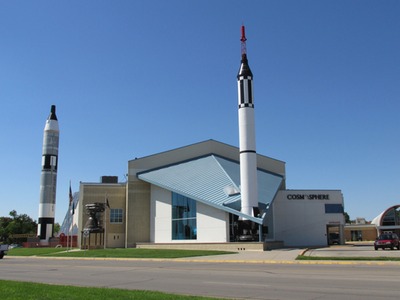The cosmos in a cornfieldby Dwayne A. Day
|
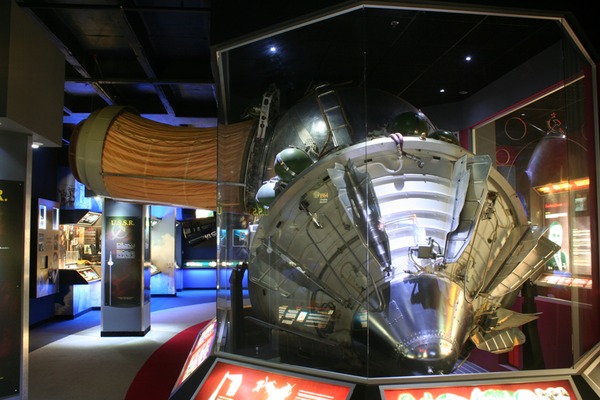 |
But museums are more than their artifacts. The most significant space artifacts lose their magic if they’re simply displayed in a warehouse without any context. That’s one of the problems with the Smithsonian’s Udvar-Hazy Museum, where most of the artifacts are displayed with little description and very little explanation of how they fit into a larger history of aircraft or space exploration. The Cosmosphere does an excellent job of putting its artifacts in context with highly attractive and informative displays.
After descending a flight of stairs and passing through a small lobby the visitor enters a short hallway and then the first real gallery, which focuses on World War II and the development of German rocketry. The displays and their captions do not glorify the machines, but explain their human cost. To the museum’s credit they make several important points, including that fact that historians believe that more people died building the V-2 in slave labor camps than were killed in its attacks, and also that Hitler’s decision to build such a costly and relatively ineffective weapon was a strategic blunder.
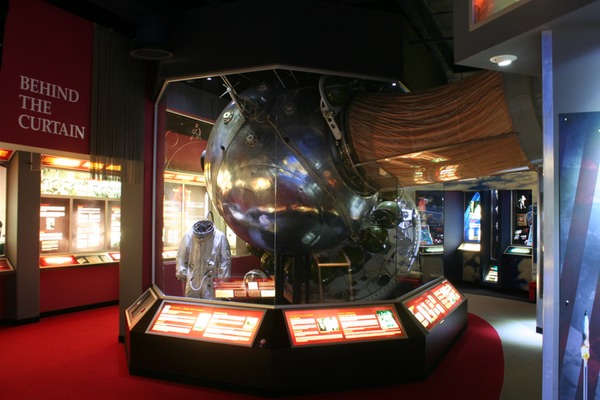 |
After that the visitors enter several hallways and small galleries that explain the Cold War origins of the missile and space races. Unfortunately, the narrative here is typical of that found in several other space museums as well as many space history books. For the sake of simplicity, the curators have reduced the story to a rivalry between Wernher von Braun in the United States and Sergei Korolev in the Soviet Union. But although von Braun was clearly the most visible rocket designer in the United States, he was by no means the only one. Indeed, many of the artifacts on display at the museum, such as the Titan II ICBM that stands outside the building, or the Atlas missile shown in numerous photographs, were not built by von Braun or his team. The United States had no shortage of missile and rocketry talent, but none of them were as vocal and public as von Braun. Similarly, the Soviet Union possessed many well-educated and talented engineers who developed a host of missile and spacecraft systems. The regrettable effect of this museum storyline is that it contributes to the myth that “our Germans were better than their Germans” during the space race, when the reality was that both superpowers had their own indigenous talent.
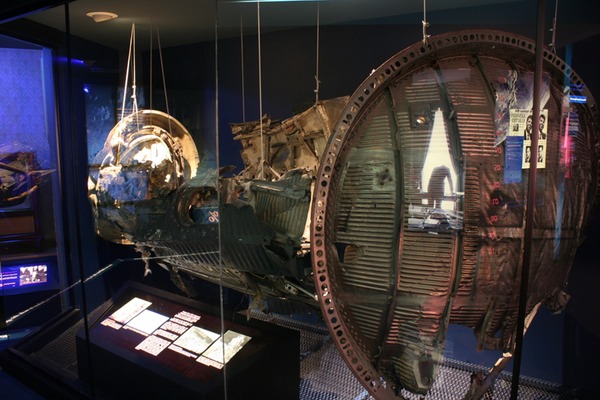 |
This is, however, the only negative aspect of what is otherwise a well-written and engaging story. The Cosmosphere also deserves substantial praise for doing something that most other museums mostly ignore: discussing the causes and consequences of failure. One of my favorite artifacts in the museum is a heavily damaged Mercury boilerplate capsule from the Mercury-Atlas 1 mission. What most museums would consider junk, the Cosmosphere has made into a dramatic statement. The capsule appears near a video screen showing endless footage of American rockets blowing up, as well as the cracked thick glass from a missile bunker, damaged from an explosion over which is printed a great quote from rocket designer Milton Rosen that should be shown to every space enthusiast hyperventilating about the latest set of NASA PowerPoint charts or an offhand comment from Elon Musk. Rosen said: “It looked so easy when you did it on paper—where valves never froze, gyros never drifted, and rocket motors didn’t blow up in your face.”
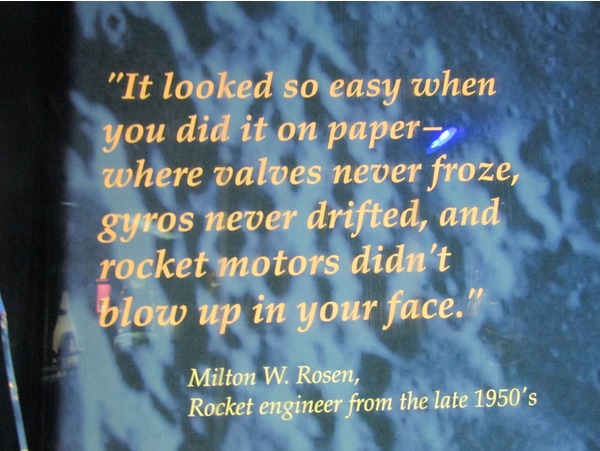 |
Soon the visitors enter one of the main exhibit areas of the museum, which cleverly tells the story of the superpower space race of the 1960s. Half of the room is colored red and filled with Soviet space objects and text about the Soviet human spaceflight program, and the other half is blue, telling the American story.
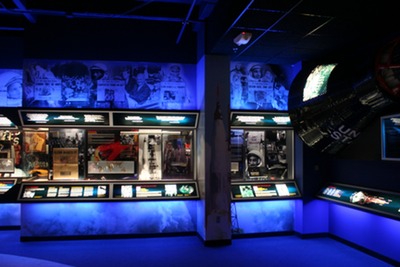 |
The Cosmosphere has gathered a number of Russian-made space artifacts. Many of these spacecraft are actually late-model robotic spacecraft that the museum has dressed up to look like the human spacecraft that they are descended from. For example, the Vostok and Voskhod spacecraft that carried cosmonauts into orbit in the 1960s were similar to and shared many components with reconnaissance and remote sensing satellites. When some of the latter became available for sale in the 1990s, the Cosmosphere acquired them and repainted and displayed them as 1960s-era Soviet spacecraft, with small labels that correctly identify them.
Also in this exhibit gallery is one of the museum’s prize artifacts, Gus Grissom’s Liberty Bell 7 spacecraft recovered from the bottom of the ocean after being lost for nearly four decades. The spacecraft had just been removed when I visited, and is currently on loan to a European museum until next year. It has been replaced with a Mercury spacecraft mockup. Nearby is the Gemini X spacecraft.
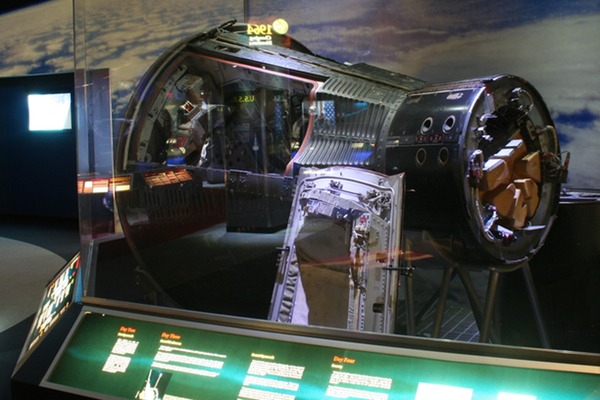 |
A short hallway leads to the next major gallery, which tells the story of the Apollo program. This contains another prize artifact, the Apollo 13 spacecraft. The fact that both Liberty Bell 7 and Apollo 13 are at the Cosmosphere is not entirely coincidental. In many ways both were unwanted artifacts of the space age and the museum set their sights on them early on. As the museum was developing in the 1970s and 1980s, curators identified important artifacts that they might be able to acquire given the fact that bigger and more prestigious museums had laid claim to the most famous and historically significant spacecraft. Part of this quest included developing a top quality restoration capability at the museum.
Curators started noticing numerous parts of the interior of Apollo 13 were in storage and realized that, after returning to Earth, the spacecraft had been disassembled for engineering purposes. Because the Apollo 13 mission was widely considered by many in the United States and NASA to be a failure, there were few objections when the spacecraft was shipped overseas, minus its many parts. After the Cosmosphere had developed a reputation for top quality artifact restoration, they struck a deal with the Smithsonian Institution, which owned the Apollo 13. The deal was that the Cosmosphere would fully restore the spacecraft in return for the right to display it.
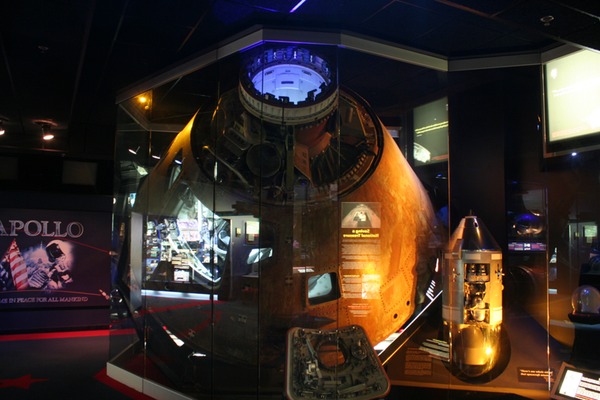 |
Eventually the spacecraft returned to the United States, was restored by museum curators, and is now the center of an attractively lit exhibit space. The spacecraft is surrounded by other objects, such as a fuel cell like the one that failed during the mission, and a full-scale mockup of the Lunar Module that would have, should have, carried Jim Lovell and Fred Haise to the lunar surface.
At this point in the museum the strong narrative that has held together for so long starts to break down. There are full-size mockups of the Apollo and Soyuz spacecraft, but almost nothing about Skylab. There is a small exhibit devoted to the Space Shuttle, but it is incomplete and dated, although the museum’s main lobby includes part of a full-scale shuttle mockup. The museum also displays the ground-based flight simulator for SpaceShipOne, but other than that there is hardly any discussion of the last twenty-five years of human spaceflight. The museum’s major omission throughout is a lack of mention of robotic spaceflight: no Voyager, Galileo, Cassini, or Mars rovers, let alone comsats, navsats, metsats, or any of the other robotic spacecraft that circle the Earth.
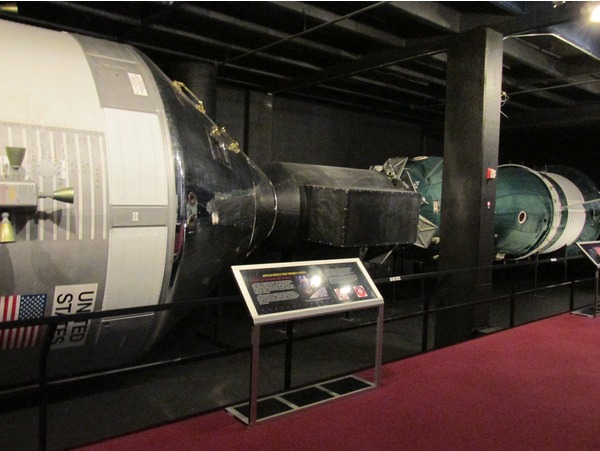 |
These omissions, and the petering out of the story by the 1980s, are understandable. The Cosmosphere could not cover everything and had to be selective, and for the most part the curators made excellent choices and did a great job displaying them. Perhaps at some point in the future the museum will be able to expand and add more shuttle-era artifacts displayed with the same care and expertise that it has shown for many of its space race era objects.
Go see for yourself, there really is a fantastic space museum in one of the last places you would expect it.
